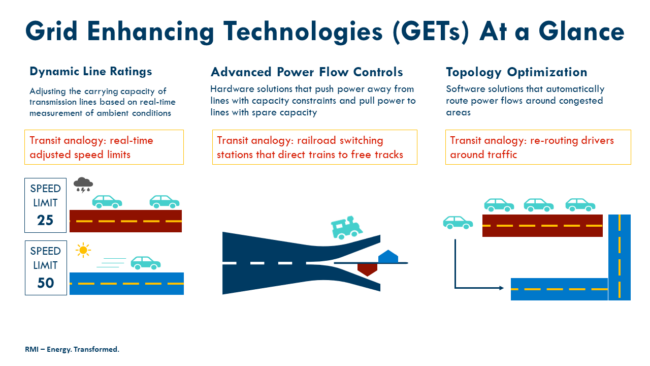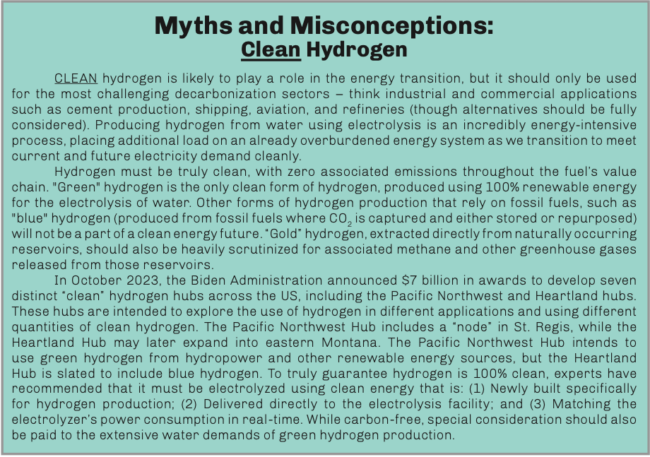
By Nick Fitzmaurice
Previous Down to Earth issues have explored the concept of the energy transition, numerous interrelated transformations that must be achieved simultaneously to decarbonize local and global energy systems and address the climate crisis. Past installments have addressed electrification, electricity decarbonization, and demand side management, while this article will explore transmission infrastructure expansion to ease renewable energy bottlenecks and bolster grid reliability.
Transmission as a Bottleneck
Transmission is currently the greatest bottleneck to the energy transition. While developers race to build wind, solar, and energy storage resources, progress is impeded by an antiquated electric transmission system desperately needing upgrades and expansion. In fact, the amount of renewable electricity capacity waiting to connect to the U.S. electric grid is equal to about twice the total installed electric generation capacity in the U.S. at the end of 2023. According to a recent expert report, “[m]ore than 12,400 MW of new generating resources have applied to [connect to NorthWestern Energy’s transmission system]. 6,700 MW of these are under construction or in the final stages of the approval process … and have planned in-service dates before 2027.”
Renewable energy generation in a more connected grid can reliably meet energy demand in all conditions, complementing regional weather patterns to move energy from where it is available to where it is needed. According to a recent study by the National Renewable Energy Lab, Montana boasts the second-highest wind energy potential and fourth-highest solar energy potential in the U.S. While these abundant energy sources represent the cheapest forms of electricity, they have yet to be tapped. A further impediment is Montana’s monopoly utility which would rather pad its executives’ and shareholders’ pockets by investing in the most expensive fossil fuel infrastructure available than save customers money with clean and reliable energy; however, transmission poses a real constraint to fully developing this renewable potential. Luckily, many regional transmission planning processes are underway, including those spurred by the recent Federal Energy Regulatory Commission (FERC) Order 1920, which requires transmission operators to produce long-term transmission plans every five years. These plans cover necessary transmission system upgrades, with backstop guidance for how to allocate costs between various system users.
Decarbonizing Montana’s energy system will not be possible without building out new transmission lines and upgrading existing transmission infrastructure locally, regionally, and nationally. Navigating challenges of cost allocation, permitting, and public support for new transmission builds is essential but could take up to a decade. In the meantime, upgrading existing transmission infrastructure can produce many of the same benefits at a fraction of the cost and time. For example, addressing existing transmission bottlenecks using high-performance wires (known as reconductoring) can allow more electricity to pass through a given line with limited to zero service interruption and a co-benefit of reduced wildfire risk. Furthermore, Grid Enhancing Technologies (GETs) can allow for better utilization of the entire transmission system. Grid upgrades such as reconductoring and GETs must be installed in the interim as developers navigate the obstacles to building new transmission infrastructure.
GETs are relatively cheap and easy to deploy, with the potential to increase the capacity of existing transmission lines by as much as 40%. They include digital technologies and advanced communication devices that monitor transmission lines, transformers, and substations to use these assets more efficiently based on real-time grid conditions. These technologies have been used in Europe for years, but utilities in the U.S. are only beginning to adopt them. GETs have recently drawn attention in numerous states, and Montana has the opportunity to join this movement. The three main GETs are Dynamic Line Ratings, Advanced Power Flow Controls, and Topology Optimization.

GETs: Dynamic Line Ratings
Currently, most transmission systems use high safety factors to limit electricity flow through the system based on the most extreme weather conditions he infrastructure might encounter seasonally or throughout its operating life. This avoids overloading the system with too much electricity in weather extremes where overheating may damage infrastructure or ignite wildfires from super-heated sagging lines. However, higher capacities can be achieved in most weather conditions if lines are monitored in real-time. Technology such as LiDAR imaging from transmission towers, in-line sensors, or data from nearby weather stations can monitor real-time line temperatures and forecast future temperatures so operators can maximize power flow throughout the system.
GETs: Advanced Power Flow Controls
Today’s electricity grid is more rudimentary than many would think, with grid power flow controlled by manually flipping switches at stations and substations throughout the system. This control can be achieved remotely and more strategically by installing digital control devices at substations between generators and electric loads so operators can optimize power flow, ease overburdened circuits, and safely move more power when possible.
GETs: Topology Optimization
By incorporating a digitalized system-wide electricity grid model, specialized software can monitor and balance electricity flow throughout the system. Rather than a fallible human operator, this software mathematically determines and remotely programs optimal grid configurations in real time.

This article was published in the October 2024 issue of Down To Earth.

